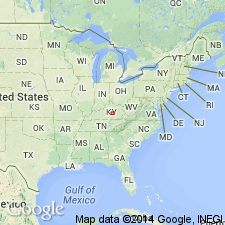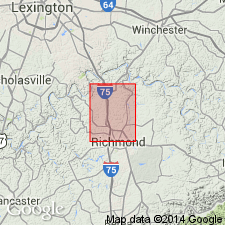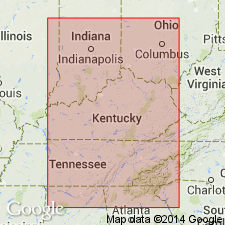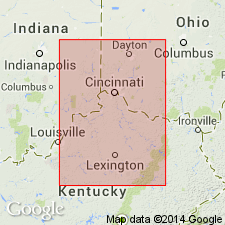
- Usage in publication:
-
- Ashlock Formation*
- Modifications:
-
- Original reference
- Dominant lithology:
-
- Mudstone
- Limestone
- AAPG geologic province:
-
- Cincinnati arch
Summary:
Pg. D9-D16, D20+ (measured sections). Ashlock Formation. Lower part chiefly limy and dolomitic mudstone; middle part chiefly limestone and argillaceous limestone; upper part greenish-gray unfossiliferous limy and dolomitic mudstone overlain by gray thin-bedded fossiliferous silty, granular limestone. Thickness 125 to 145 feet; 133 feet at type section. Southwest of Richmond includes five members (ascending): Tate (redefined), Gilbert (redefined), and Stingy Creek, Terrill, and Reba (all new). Rocks previously included in (ascending) McMillan Formation of Maysville Group and Arnheim Formation of Richmond Group by Palmquist and Hall, 1960 (USGS Hydro. Inv. Atlas HA-20) and 1961 (USGS Water-Supply Paper 1533). Conformably overlies Calloway Creek Limestone (new); conformably underlies Drakes Formation (new). Age is Late Ordovician.
Type section: outcrops along north bank of Dix River and in roadcuts of U.S. Highway 27 north of river, [approx. Lat. 37 deg. 34 min. 24 sec. N., Long. 84 deg. 36 min. 51 sec. W.], Lancaster 7.5-min quadrangle, Lincoln Co., KY.
Reference section: along north bank of Dix River beginning 0.8 mi west of U.S. Highway 27, about 4 mi north of Stanford, [approx. Lat. 37 deg. 34 min. 30 sec. N., Long. 84 deg. 37 min. 49 min. W.], Stanford 7.5-min quadrangle, Lincoln Co., KY.
Named from Ashlock Cemetery near U.S. Highway 27 about 0.1 mi north Dix River, Lancaster 7.5-min quadrangle, northeastern Lincoln Co., KY.
Source: Publication; US geologic names lexicon (USGS Bull. 1350, p. 34).

- Usage in publication:
-
- Ashlock Formation*
- Modifications:
-
- Revised
- AAPG geologic province:
-
- Cincinnati arch
Summary:
Ashlock Formation. In Richmond North quadrangle, Madison and Fayette Counties, south-central Kentucky, formation comprises (ascending) Tate, Grant Lake, Terrill, and Reba Members. Overlies Calloway Creek Limestone. Underlies Drakes Formation. [Age is Late Ordovician.]
Source: US geologic names lexicon (USGS Bull. 1350, p. 34).

- Usage in publication:
-
- Ashlock Formation*
- Modifications:
-
- Areal extent
- AAPG geologic province:
-
- Cincinnati arch
Summary:
The Ashlock Formation in south-central KY is divided into the (ascending) Tate, Stingy Creek, Gilbert, Terrill, and Reba Members. Consists of mudstone, limestone, and siltstone. Thickness 125 to 145 feet. Overlies Calloway Creek Limestone. Underlies Grant Lake Limestone or Drakes Formation. Northward, grades laterally into Fairview Formation. Age is Late Ordovician (late Maysvillian and early Richmondian).
Source: Modified from GNU records (USGS DDS-6; Reston GNULEX).

- Usage in publication:
-
- Ashlock
- Modifications:
-
- Not used
- AAPG geologic province:
-
- Cincinnati arch
Summary:
The Cincinnatian Series is divided into five depositional sequences in this report, which correspond to lithostratigraphic units. The following stratigraphic names in KY should be abandoned as they have been applied to bodies of rock already named in downramp areas of OH and IN: Bardstown (=Lower Whitewater), Reba (=Oregonia), Stingy Creek (=Mount Auburn), Calloway Creek (=Bellevue), and Clays Ferry (=Fairview). The following units in KY, OH, and IN lump dissimilar facies and straddle sequence boundaries and therefore should be abandoned: Drakes, Ashlock, Dillsboro, Tanners Creek, and Bull Fork. Grant Lake has been defined in several different ways and consequently should be abandoned. Several units will be redefined at a later date, including the Upper Whitewater and the "Sunset" and "Saluda" of OH and IN. Formal naming of new lithostratigraphic units will follow further study.
Source: GNU records (USGS DDS-6; Reston GNULEX).
For more information, please contact Nancy Stamm, Geologic Names Committee Secretary.
Asterisk (*) indicates published by U.S. Geological Survey authors.
"No current usage" (†) implies that a name has been abandoned or has fallen into disuse. Former usage and, if known, replacement name given in parentheses ( ).
Slash (/) indicates name conflicts with nomenclatural guidelines (CSN, 1933; ACSN, 1961, 1970; NACSN, 1983, 2005, 2021). May be explained within brackets ([ ]).

